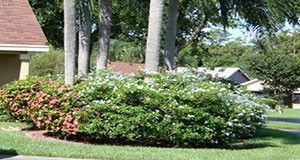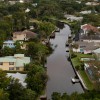
Early efforts to promote Florida-Friendly landscapes emphasized the use of drought-tolerant plants, which created a negative association with a visually unappealing landscape. This has hampered the promotion of FFL yards and the adoption by homeowner associations. But recently many homeowners are rethinking their landscape maintenance and plant choices and HOAs are considering promoting environmentally friendly landscapes but express uncertainty about recommending FFL because of the need to maintain visual quality. We conducted a study to address both groups’ concerns and help develop FFL-oriented landscape codes that meet both groups’ needs. This 7-page fact sheet was written by Gail Hansen, Laura Warner, Paul Monaghan, Emily Ott, Tim Fogarty, Claire Lewis, and Esen Momol, and published by the UF Department of Environmental Horticulture, April 2015.
http://edis.ifas.ufl.edu/ep519
Tag: Timothy Fogarty
Extension and Community Resilience: Improving Community Disaster Preparedness Using Online Resources
 As Extension agents work to improve the quality of life in their communities, they must increase the capacity to respond to disasters, especially in high risk areas (which includes most of coastal Florida). Community Resiliency is a community’s ability to quickly recover from adversity and it can be enhanced through planning and adaptation using easily available online resources. This 4-page fact sheet describes supplemental educational materials that can be added to community resiliency training, offering background information and specific tools for disaster preparation. Written by Emily Ott, Paul Monaghan, and Timothy Fogarty, and published by the UF Department of Agricultural Education and Communication, October 2014. (UF/IFAS photo by Milt Putnam)
As Extension agents work to improve the quality of life in their communities, they must increase the capacity to respond to disasters, especially in high risk areas (which includes most of coastal Florida). Community Resiliency is a community’s ability to quickly recover from adversity and it can be enhanced through planning and adaptation using easily available online resources. This 4-page fact sheet describes supplemental educational materials that can be added to community resiliency training, offering background information and specific tools for disaster preparation. Written by Emily Ott, Paul Monaghan, and Timothy Fogarty, and published by the UF Department of Agricultural Education and Communication, October 2014. (UF/IFAS photo by Milt Putnam)
http://edis.ifas.ufl.edu/wc187
Measuring Community Resilience using Online Toolkits
 When we return to the scene of recent disasters like New Orleans, we find that some communities and neighborhoods are able to recover faster than others, while some never completely recover. Community Resilience is defined as the ability for a community to bounce back from a disaster, adapt to changes, and become more sustainable. The resilience assessment and planning tools reviewed here range from simple, ready-to-print worksheets intended for use by average citizens to comprehensive planning exercises more appropriate for city planners, emergency service providers, and elected officials. Not all of the toolkits will apply to every community. This 6-page fact sheet was written by Paul Monaghan, Emily Ott, and Timothy Fogarty, and published by the UF Department of Agricultural Education and Communication, July 2014. (UF/IFAS photo by Tyler Jones)
When we return to the scene of recent disasters like New Orleans, we find that some communities and neighborhoods are able to recover faster than others, while some never completely recover. Community Resilience is defined as the ability for a community to bounce back from a disaster, adapt to changes, and become more sustainable. The resilience assessment and planning tools reviewed here range from simple, ready-to-print worksheets intended for use by average citizens to comprehensive planning exercises more appropriate for city planners, emergency service providers, and elected officials. Not all of the toolkits will apply to every community. This 6-page fact sheet was written by Paul Monaghan, Emily Ott, and Timothy Fogarty, and published by the UF Department of Agricultural Education and Communication, July 2014. (UF/IFAS photo by Tyler Jones)
http://edis.ifas.ufl.edu/wc172